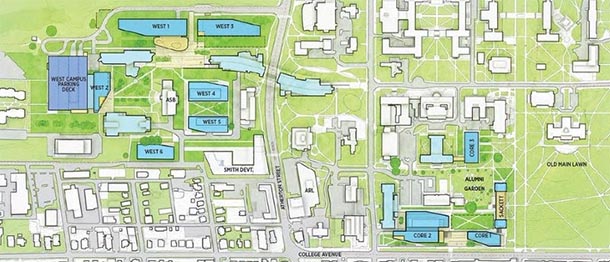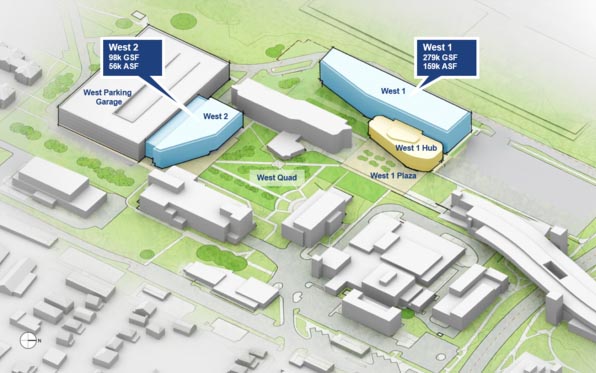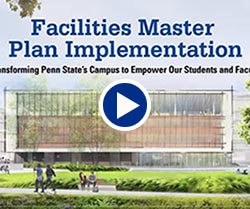
The facilities master plan for the College of Engineering includes several new buildings on West Campus, as well as a reimagining of the current engineering footprint near Old Main Lawn. IMAGE: PENN STATE
Planned expansion to keep College of Engineering on leading edge
New facilities to support innovation at Penn State
12/3/2019
By Andrew Krebs and Ashley WennersHerron
UNIVERSITY PARK, Pa. — Design work is progressing for the first stage of a proposed, decade-long, multi-phase plan that will transform the Penn State College of Engineering and its footprint on the University Park campus. The college is one of the largest of its kind in the country and ranks among the best in the nation in multiple disciplines.
The initial five-year phase of the plan includes two new buildings that will serve as anchors to a new central engineering hub to the west of North Atherton Street, adding 377,000 gross square feet to the college’s infrastructure. Phase one, which is projected to conclude in 2023, also includes proposed renovations to Sackett Building and the demolition of Hammond Building along College Avenue and the Engineering Units behind Hammond.
In February 2019, the Penn State Board of Trustees’ Committee on Finance, Business and Capital Planning approved Payette, of Boston, Massachusetts, to design the two new buildings on West Campus. The final design plan for the first building is expected to go to the Board of Trustees for review in fall 2020, with board review of the design for the second building expected in spring 2021.
“This undertaking represents a critical investment that will help to keep Penn State on the leading edge of innovation, with a focus on finding solutions to challenges that affect people in Pennsylvania and around the globe,” said Executive Vice President and Provost Nicholas P. Jones. “The planned facilities will enable current and future students, faculty and staff to engage in experiential learning while continuing critical and inspirational work — such as the Dragonfly mission to Saturn’s moon Titan — and the development of renewable energy technologies for use here on Earth. These projects and others advance the University’s strategic priorities and have a significant impact beyond Penn State.”
The total estimated cost for phase one design, construction, renovation and demolition is projected at $370 million, with the University and the Commonwealth of Pennsylvania as primary funding sources. Additionally, a capital campaign is underway to provide further project support.
“This planned expansion represents an unprecedented transformation of the College of Engineering,” said Justin Schwartz, Harold and Inge Marcus Dean of Engineering. “We’re doing more than just adding buildings — we are enhancing the ability of our students and faculty to impact engineering and technology through research- and education-centered physical facilities. The new infrastructure is vital to keep us on the cutting-edge of engineering education and research.”
A necessary expansion
The College of Engineering at University Park, which is spread across nearly 50 campus buildings, is the largest college at Penn State and one of the largest colleges of engineering in the nation. Over the past decade, student enrollment in the college has increased by more than 40% and the number of tenure-track faculty has increased by nearly 25%. Currently, there are more than 12,000 undergraduate and graduate-level engineering students and more than 300 tenure-track faculty.
“We have grown as a college and will continue to strategically do so, particularly in the areas of graduate enrollment and through faculty recruitment,” Schwartz said. “This tremendous growth in people, and the corresponding growth of our research enterprise that now totals almost $150 million annually, has highlighted a need for increased and more modern facilities that are better consolidated on campus.”
In 2018, Penn State engaged Payette to develop a master plan and framework to increase the quantity, improve the quality and optimize the distribution and organization of the college’s physical space across two budgetary funding cycles: 2018-23 and 2023-28.
An engineering hub on West Campus
The two new engineering buildings currently in design — West 1 and West 2 — will house flexible classrooms, multi-use design studios, maker spaces, high-bay research labs, faculty offices and research cores to benefit multiple engineering academic departments.
West 1, the larger of the two buildings at 279,000 gross square feet, also will house a knowledge commons with collaborative student workspaces, departmental administrative and faculty offices, and research laboratories, as well as food service and pedestrian connections, positioning the building as a welcoming and active University hub.
Both buildings will become part of a re-imagined West Quadrangle, defined by Leonhard Building to the south, Applied Science Building to the east, and Earth and Engineering Sciences Building to the north.
Beyond 2023
After the planned conclusion of phase one, the master plan recommends a second five-year phase that includes construction on the footprint of the demolished Hammond Building and Engineering Units, further renovations to Sackett Building and the addition of a third building to West Campus.
This second phase, which will require Board of Trustees approval before moving forward, has a projected cost of $479 million and would likely also be funded by Penn State, the commonwealth, and philanthropy.
“These initiatives clearly represent a significant investment in engineering by Penn State,” Schwartz said. “We will be optimally positioned as a leader in engineering education and research, with the resources and facilities to help our students and faculty collaborate and innovate as they address society’s largest challenges.”




